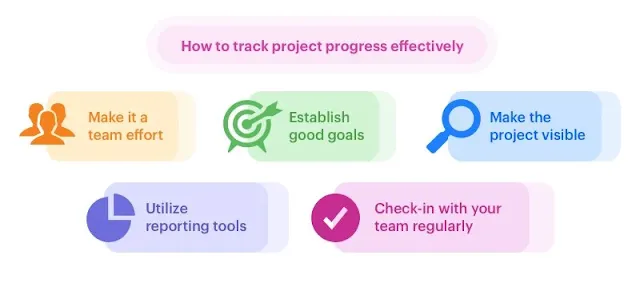Tracking project progress is an essential aspect of project management, as it enables project managers to monitor project performance, identify issues, and make necessary adjustments to keep the project on track. Here are the steps involved in tracking project progress:
Define Project Goals and Objectives: Before starting a project, it is crucial to define the goals and objectives. This involves determining the desired outcome, deliverables, timelines, and budget. The project goals and objectives serve as the foundation for tracking progress.
Identify Project Milestones: After defining the project goals and objectives, the next step is to break down the project into smaller, more manageable tasks or milestones. These milestones help in measuring progress and ensure that the project is moving forward as planned.
Establish Metrics for Measuring Progress: Once the milestones have been identified, it is essential to establish metrics for measuring progress. These metrics could include the number of tasks completed, the percentage of the project completed, and the number of resources utilized.
Assign Tasks and Responsibilities: Once the milestones and metrics have been established, the project manager assigns tasks and responsibilities to team members. Each team member must understand their roles and responsibilities and the expected outcomes for their tasks.
Monitor Progress: The project manager should monitor progress regularly to ensure that the project is on track. This can be done by setting up regular status meetings, using project management software, or reviewing progress reports.
Identify Issues and Risks: During the project, the project manager should identify issues and risks that could impact progress. These issues could include resource constraints, missed deadlines, or unexpected costs. Risks could include delays due to weather or unforeseen events.
Make Adjustments: Once issues and risks have been identified, the project manager should make necessary adjustments to keep the project on track. This may involve reallocating resources, revising timelines, or adjusting the budget.
Communicate Progress: It is crucial to communicate progress regularly with stakeholders, team members, and other key parties involved in the project. This communication should include progress reports, status updates, and any changes to the project plan.
In conclusion, tracking project progress involves defining project goals and objectives, identifying milestones, establishing metrics for measuring progress, assigning tasks and responsibilities, monitoring progress, identifying issues and risks, making adjustments, and communicating progress. By following these steps, project managers can ensure that projects are completed on time, within budget, and meet the desired outcomes

Comments
Post a Comment